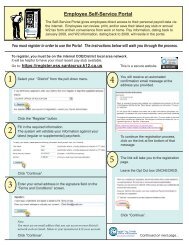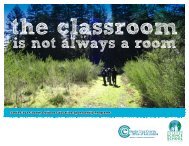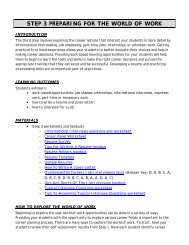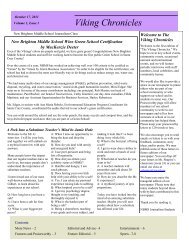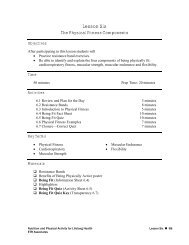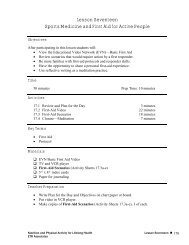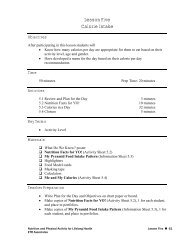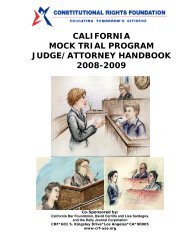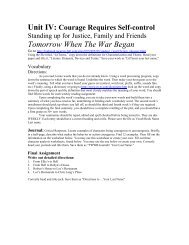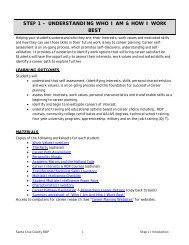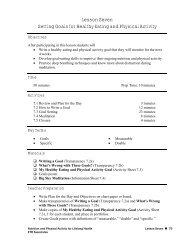Course Lessons - Physical Education for Body, Mind and Spirit
Course Lessons - Physical Education for Body, Mind and Spirit
Course Lessons - Physical Education for Body, Mind and Spirit
You also want an ePaper? Increase the reach of your titles
YUMPU automatically turns print PDFs into web optimized ePapers that Google loves.
Lesson TwoNutrients <strong>and</strong> the <strong>Body</strong>ObjectivesAfter participating in this lesson, students will• Be able to identify key nutrients the body needs <strong>and</strong> describe their function <strong>and</strong>importance.• Underst<strong>and</strong> that bodies are affected by the types of nutrients taken in through food<strong>and</strong> drink.TimeActivitiesKey Terms50 minutes Prep Time: 10 minutes2.1 Review <strong>and</strong> Plan <strong>for</strong> the Day 3 minutes2.2 Introduction to Nutrients 10 minutes2.3 Nutrient Groups/Presentations 27 minutes2.4 Closure—True/False Game 10 minutes• Nutrients• Carbohydrates• Proteins• Fats• Vitamins• Minerals• WaterMaterials Poster of human body Food Model cards Nutrition Template (Activity Sheet 2.3) <strong>for</strong> each of the 6 Nutrients NutritionTemplate (Transparency 2.3) Nutrients (In<strong>for</strong>mation Sheets 2.3 a-f) True or False Nutrient Statements (In<strong>for</strong>mation Sheet 2.4) Scrap paper Optional: Job cards <strong>for</strong> small groupsNutrition <strong>and</strong> <strong>Physical</strong> Activity <strong>for</strong> Lifelong Health Lesson Two • 20ETR Associates
Teacher Preparation• Order or create Food Model cards.• Write Plan <strong>for</strong> the Day <strong>and</strong> Objectives on chart paper or board.• Draw an outline of a human body on chart paper.• Make copies of Nutrients (In<strong>for</strong>mation Sheets 2.3 a-f), 2 copies of each.• Make 6 copies of Nutrition Template (Activity Sheet 2.3), 1 per group.• Make transparency of Nutrition Template (Transparency 2.3).• Make 1 copy of True or False Nutrient Statements (In<strong>for</strong>mation Sheet 2.4).2.1 Review <strong>and</strong> Plan <strong>for</strong> the Day 3 minutesMaterials: Plan <strong>for</strong> the Day <strong>and</strong> ObjectivesWrite the Plan <strong>for</strong> the Day <strong>and</strong> Objectives on the board be<strong>for</strong>e class, listing all of theactivities students will be doing.Plan <strong>for</strong> the Day:• Introduction to Nutrients• Nutrient Groups/Presentations• Closure—True/False GameReview the previous class by asking students to name a component of health <strong>and</strong> how theyhave addressed it in the past few days.Explain that today’s focus will be learning about nutrients. They will be working in groups<strong>and</strong> making presentations on a specific nutrient. Then they will participate in a game that willtest their knowledge about the nutrients.Review the Objectives with students.2.2 Introduction to Nutrients 10 minutesMaterials: Chart paper <strong>and</strong> markers, poster of human body, Food Model cardsExplain that in this lesson students will be learning some basic nutritional in<strong>for</strong>mation <strong>for</strong>making healthy food choices. Begin by providing some in<strong>for</strong>mation about the importance ofnutrients (substances that provide nourishment <strong>for</strong> the body’s growth or metabolism) in thediet.• Explain that the body is just like a car. Cars need fuel to run, <strong>and</strong> so do our bodies.Food is the fuel our bodies use to function. Demonstrate this point by showing thedrawing of a body <strong>and</strong> explaining that this is our fuel tank. H<strong>and</strong> out a few FoodModel cards to students <strong>and</strong> have them each select two foods that they eat or like.Nutrition <strong>and</strong> <strong>Physical</strong> Activity <strong>for</strong> Lifelong Health Lesson Two • 21ETR Associates
Have them to tape the cards to the body poster. Bring students’ attention to the body,which is now full of food. Ask them to notice that it’s full of different kinds of foods.• Explain that it’s important to consume different types of fuel. Note that, while ourbodies can utilize many kinds of fuel, they are affected over time by the type of fuel,or food, that we take in. So it’s important to know what types of “fuel” we’re puttinginto our bodies. Explain that the most basic element of “fuel” is the nutrient.• Tell the students that there are six basic Nutrients:- Carbohydrates (nutrient that gives us high amounts of quick energy)- Fats (nutrient that gives us stored energy)- Proteins (nutrient that builds muscle <strong>and</strong> bones)- Vitamins (nutrient that helps regulate body processes)- Minerals (nutrient essential to growth <strong>and</strong> metabolism)- Water (essential <strong>for</strong> digestion, respiration, carrying nutrients <strong>and</strong> oxygen)Explain that all of these nutrients are needed to maintain a healthy body.• Write the six nutrients on chart paper or the board.• Explain that students will be working in groups to learn more about the individualnutrients by answering some specific questions.2.3 Nutrient Groups/Presentations 27 minutesMaterials: Nutrition Template (Activity Sheet 2.3), Nutrition Template (Transparency2.3), Nutrients (In<strong>for</strong>mation Sheets 2.3 a-f), pencilsExplain that each group will get a Nutrients in<strong>for</strong>mation sheet. They will then answer thefollowing questions <strong>and</strong> record their answers on the Nutrition Template (Activity Sheet2.3). (Note: The Nutrients in<strong>for</strong>mation sheets were designed <strong>for</strong> basic-level readers.Students with more advanced reading skills can find the in<strong>for</strong>mation in a health textbook orbooks on nutrients from the library.)Display the Nutrition Template transparency <strong>for</strong> students to see the following questions:1. What does this nutrient do <strong>for</strong> your body? (“The Good News”)2. What happens to your body if you get too much or too little of the nutrient? (“TheBad News”)3. What foods do you enjoy that are good sources of this nutrient? (“Come <strong>and</strong> GetIt”)4. Why is it important <strong>for</strong> you to eat the right amount of the nutrient? (“BottomLine”)Once you have explained what each group will be doing:• Form 6 groups.• Give a different Nutrients in<strong>for</strong>mation sheet—2 copies—to each group.Nutrition <strong>and</strong> <strong>Physical</strong> Activity <strong>for</strong> Lifelong Health Lesson Two • 22ETR Associates
• Jobs can be assigned, if you have groups of 4 or more. Have job cards to give to eachstudent in the group: Reader (reads the in<strong>for</strong>mation provided), Writer (writes theresponses to questions), Presenter (presents the in<strong>for</strong>mation), Facilitator (keeps thegroup on task) <strong>and</strong> Timekeeper (keeps track of allotted time).• Allow time <strong>for</strong> each group to read <strong>and</strong> discuss the in<strong>for</strong>mation sheet. As they arereading, they should look <strong>for</strong> the answers to the questions <strong>and</strong> make note of theanswers on the Nutrition Template activity sheet.• Tell groups to come up with a statement <strong>for</strong> each of the four questions on the activitysheet <strong>and</strong> to be prepared to complete a 2-minute presentation based on their notes.The presentations will be done after every group has completed the activity sheet.Have each group present the in<strong>for</strong>mation they learned about their nutrient. Have theNutrition Template transparency available to use as a reference.• Be<strong>for</strong>e groups present, review presentation skills:° Speak clearly <strong>and</strong> loudly.° Face the class.° Make eye contact with classmates around the room.° The class shows support by listening to what the presenters are saying.• Have groups volunteer <strong>for</strong> their turn <strong>and</strong> make their presentations.2.4 Closure—True/False Game 10 minutesMaterials: True or False Nutrient Statements (In<strong>for</strong>mation Sheet 2.4), scrap paper, pencilsExplain that you are going to read some statements about nutrients <strong>and</strong> students have todecide whether the statement is true or false.Have the entire class st<strong>and</strong> in a line on one side of the room. Give each student a piece ofscrap paper <strong>and</strong> a pencil. Tell them that you are going to read a statement <strong>and</strong> they have towrite down whether they think the statement is “True” or “False.”Read one of the statements <strong>and</strong> have students write their answer down on the piece of scrappaper. Give the correct answer to the statement. If students got it right, have them take a step<strong>for</strong>ward, if not, they stay where they are. Continue with the rest of the statements <strong>and</strong> seehow many steps <strong>for</strong>ward students come.ResourcesFood Models: For General Audiences (200 models on 54 cards)National Dairy Council 1-800-426-8271Product code 0012NNutrition <strong>and</strong> <strong>Physical</strong> Activity <strong>for</strong> Lifelong Health Lesson Two • 23ETR Associates
NutrientNutrition Template_________________________________Activity Sheet 2.3The Good NewsThe Bad NewsCome <strong>and</strong> Get ItBottom LineMaking sure I eat the right amount of_________________________ isimportant to me because…Nutrition <strong>and</strong> <strong>Physical</strong> Activity <strong>for</strong> Lifelong Health Lesson Two • 24ETR Associates
Transparency 2.3NutrientNutrition Template_________________________________The Good NewsThe Bad News(What does thisnutrient do <strong>for</strong> YOURbody?)(What happens to YOURbody if you get too muchor too little of thenutrient?)Come <strong>and</strong> Get ItBottom Line(What foods do youenjoy that are goodsources of thisnutrient?)(Why is it important <strong>for</strong>you to eat the rightamount of this nutrient?)Making sure I eat the right amountof _______________________ isimportant to me because…Nutrition <strong>and</strong> <strong>Physical</strong> Activity <strong>for</strong> Lifelong Health Lesson Two • 25ETR Associates© ETR HealthSmart High School
In<strong>for</strong>mation Sheet 2.3aCarbohydratesCarbohydrates are the major part of most human diets.There are 2 types of carbohydrates.‣Complex carbohydrates• Include starches <strong>and</strong> some <strong>for</strong>ms of fiber.• About 50% of your diet should come from complexcarbohydrates.• Examples of foods containing complex carbohydrates includepasta, wheat, corn, vegetables, fruit, beans <strong>and</strong> grains.‣Simple carbohydrates• Include sugars such as glucose, fructose <strong>and</strong> sucrose.• Limit how many simple carbohydrates you eat because theydon’t add many vitamins or minerals to your diet <strong>and</strong> they have lotsof calories that contribute to weight gain.• Examples of foods containing simple carbohydrates include c<strong>and</strong>y,soft drinks, cake <strong>and</strong> cookies.What do carbohydrates do <strong>for</strong> your body?• Carbohydrates provide the body’s most important source ofenergy.• Carbohydrates are high-quality fuels because it takes littleef<strong>for</strong>t to release their energy.• Foods with complex carbohydrates also provide the bodywith fiber. A diet low in fiber may contribute to colon cancer.What if you have too little or too many carbohydrates?• A diet low in carbohydrates can result in the body having toolittle energy. Low energy levels can make you tired <strong>and</strong> less alertmentally.• Eating too many simple carbohydrates can result in obesity.Carbohydrates are turned to energy, as the body needs it. Excesscarbohydrates are stored as fat.Nutrition <strong>and</strong> <strong>Physical</strong> Activity <strong>for</strong> Lifelong Health Lesson Two • 26ETR Associates© ETR HealthSmart High School
In<strong>for</strong>mation Sheet 2.3bProteinsWhat do proteins do <strong>for</strong> your body?‣ Proteins are made up of amino acids that the body uses to make skin,muscle <strong>and</strong> bone.‣ The body requires 20 amino acids <strong>for</strong> good health.• Of these, 11 can be produced within the body itself.• The remaining 9 are called essential amino acids, because it’s essential toinclude them in your diet.• The body can’t store amino acids, so it’s important to eat some proteinalmost daily.How can you get protein in your diet?‣ Examples of foods with protein include meat, chicken, fish, eggs, dried beans <strong>and</strong>nuts.‣ Food that supplies all 9 essential amino acids is called a complete protein.‣ Almost all proteins from animal sources are complete, while plant protein sources areoften incomplete.‣ People who don’t eat animal protein can combine sources of plant proteins to besure they get the essential amino acids. For example, beans <strong>and</strong> rice, a common mealthroughout the world, <strong>for</strong>m a complete protein when eaten together.What if you have too little or too much protein?‣ Most Americans eat more protein than the body needs.‣ Only about 10-15% of your calories should come from proteins.‣ If you don’t get enough proteins from the food you eat it may cause insufficientdevelopment of bones <strong>and</strong> muscles, <strong>and</strong> problems related to skin tone.‣ There is no evidence that eating excessive amounts of protein will build more orstronger muscles. In fact, eating large amounts of protein may contribute toweight gain because many foods high in protein are also high in fats, which canincrease risk of hypertension, high cholesterol, heart disease <strong>and</strong> diabetes.Nutrition <strong>and</strong> <strong>Physical</strong> Activity <strong>for</strong> Lifelong Health Lesson Two • 27ETR Associates© ETR HealthSmart High School
Fats are compounds that include solid fats <strong>and</strong> oils.What do fats do <strong>for</strong> your body? Fats are essential:• For healthy skin <strong>and</strong> hair.• For normal growth <strong>and</strong> nerve function.• For the production of certain hormones.• To allow the body to absorb certain vitamins during digestion.Fat can be burned as energy when the body doesn’t have enoughcarbohydrates stored, but the level of the energy producedfrom fat is lower than that produced from carbohydrates. The body needs a certain amount of fat to:• Insulate against cold.• Provide energy <strong>for</strong> muscles.• Provide a layer of padding between skin <strong>and</strong> muscles.• Protect internal organs.In<strong>for</strong>mation Sheet 2.3cFATSWhat foods have fat? A trace of fat is found in almost all foods. Examples of foods with fats include meat, fish, dairy products,nuts <strong>and</strong> chocolate. Many foods, such as potatoes, have little or no fat naturally, but becomehigh in fat when cooked in oil – e.g. french fries <strong>and</strong> hash browns.What if you have too little or too much fat in your diet? Too much fat can contribute to many health problems including obesity,heart disease, diabetes <strong>and</strong> hypertension. Only 20-30% of your calories should come from fats. Some fats are healthier than others. Avoid “transfats,” <strong>and</strong> eat fatslike olive oil <strong>and</strong> canola oil.Nutrition <strong>and</strong> <strong>Physical</strong> Activity <strong>for</strong> Lifelong Health Lesson Two • 28ETR Associates© ETR HealthSmart High School
In<strong>for</strong>mation Sheet 2.3dMineralsMinerals play a vital role in nutritional healthCommon minerals include calcium, sodium, potassium,iron, iodine <strong>and</strong> zinc. Minerals are found in almost all foods. Vegetables, fruits <strong>and</strong> grain products are particularly goodsources. A balanced diet with a variety of foods can help prevent mineraldeficiency problems.What do minerals do <strong>for</strong> your body? Minerals are important <strong>for</strong> growth <strong>and</strong> maintenance of body structures. Minerals help regulate metabolism.What if you get too little or too many minerals?Having too few minerals can affect all body systems including the skeletal,cardiovascular, respiratory <strong>and</strong> reproductive systems. The effects on the body are very specific <strong>and</strong> directly related to thetype of mineral missing from the diet. For example:• Iron deficiency anemia, a condition fairly common in teenagegirls, results in a decrease in the number of red blood cells.• Not getting enough calcium restricts the proper development ofbones <strong>and</strong> results in brittle bones later in life.Too many minerals in your diet may be harmful. For example, if you drink a lot of carbonatedsodas, the high level of phosphates actuallyinterferes with calcium metabolism <strong>and</strong> mayweaken your bones.Nutrition <strong>and</strong> <strong>Physical</strong> Activity <strong>for</strong> Lifelong Health Lesson Two • 29ETR Associates© ETR HealthSmart High School
In<strong>for</strong>mation Sheet 2.3eVitaminsWhat do vitamins do <strong>for</strong> your body? Vitamins help the body produce energy. Vitamins are compounds that help regulate body processessuch as:• Digestion• Growth• Metabolism• Hormone development• Wound healing• Nerve functionHow can you get the vitamins you need? Vitamins are found in all food groups. Common sources of vitamins are fruits <strong>and</strong> vegetables.• Green leafy <strong>and</strong> yellow vegetables are especiallygood sources of vitamins A <strong>and</strong> B.• Oranges, grapefruit, lemons, limes <strong>and</strong> green chiliesare excellent sources of vitamin C.• The body makes vitamin D through exposure tosunlight.What if you don’t get enough vitamins? Vitamin deficiencies can cause a wide range of health problemsincluding several diseases rarely seen in the U.S. These include:• scurvy (caused by not enough vitamin C)• beriberi (caused by lack of vitamin B)• rickets (caused by lack of vitamin D) Vitamin deficiency in this country primarily cause:• Poor regulation of internal body processes.• The body not being able to produce high levels of energy.Nutrition <strong>and</strong> <strong>Physical</strong> Activity <strong>for</strong> Lifelong Health Lesson Two • 30ETR Associates© ETR HealthSmart High School
Nearlyall foodscontain water -Some are up to90% water.Beverages, fruitAnd vegetablesare major sources of water.In<strong>for</strong>mation Sheet 2.3fWaterThe body loses about 1 quart of water eachday. To replace body fluids, experts recommenddrinking 8 or more glasses of water daily, insteadof drinking soda, coffee, juice or other beverages.What does water do <strong>for</strong> your body?Water is an essential nutrient that makes up 50-75% of yourbody weight. Water is so important that your body can’t live <strong>for</strong>more than a few days without it. Water assists in digestion <strong>and</strong> respiration. Water helps carry nutrients <strong>and</strong> oxygen throughoutthe body.What if you have too little or too much water?Not drinking enough water can compromise all of the body’s systems.Water allows the body to: Use water-soluble vitamins. Carry oxygen in the blood. Regulate body temperature.When water deficiency is severe, the body systems shut down <strong>and</strong> death occurs.Most people do not drink enough water <strong>and</strong> drinking too much water causes few problems. Some experts believe that large amounts of water may dilute <strong>and</strong> wash water-solublevitamins from the body.Nutrition <strong>and</strong> <strong>Physical</strong> Activity <strong>for</strong> Lifelong Health Lesson Two • 31ETR Associates© ETR HealthSmart High School
In<strong>for</strong>mation Sheet 2.4True or False Nutrient Statements• Carbohydrates provide the most important source of energy to your body.True• 40% of your diet should come from fats.False, only 20 to 30% of your diet should come from fat.• Vitamins are found in only certain food groups.False, vitamins are found in all food groups. Common sources are fruits<strong>and</strong> vegetables.• Minerals are important <strong>for</strong> growth <strong>and</strong> maintenance of body structures.True• Water helps your body regulate its temperature.True• You can live without water <strong>for</strong> more than a few days.False, your body cannot go without water <strong>for</strong> more than a few days.• Our bodies need some fat to function effectively.True• You want to include a lot of simple carbohydrates in your diet.False, you don’t want to eat a lot of simple carbohydrates, such as softdrinks, cake <strong>and</strong> cookies, because those foods do not supply your bodywith many vitamins or minerals <strong>and</strong> have lots of calories that contributeto weight gain.• Most Americans eat more protein than the body needs.True• You can only get protein from animal sources (beef, chicken <strong>and</strong> fish).False, people who don’t eat animal protein can combine sources of plantproteins to be sure they get the essential amino acids. For example,beans <strong>and</strong> rice <strong>for</strong>m a complete protein when eaten together.Nutrition <strong>and</strong> <strong>Physical</strong> Activity <strong>for</strong> Lifelong Health Lesson Two • 32ETR Associates




